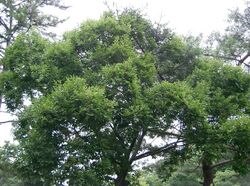Biology:Aphananthe aspera
From HandWiki
Short description: Species of tree
| Aphananthe aspera | |
|---|---|

| |
| Scientific classification | |
| Kingdom: | Plantae |
| Clade: | Tracheophytes |
| Clade: | Angiosperms |
| Clade: | Eudicots |
| Clade: | Rosids |
| Order: | Rosales |
| Family: | Cannabaceae |
| Genus: | Aphananthe |
| Species: | A. aspera
|
| Binomial name | |
| Aphananthe aspera | |
| Synonyms[1] | |
| |
Aphananthe aspera, commonly known as scabrous aphananthe[2] or muku tree,[1] is a flowering plant in the family Cannabaceae. It is found on slopes and stream banks between 100 and 1600 m. It is native to China, Taiwan, Japan, Korea, and Vietnam.[3]
Uses
It is used as an ornamental plant in Chinese classical gardens. Aphananthe aspera is a source of fibre and wood, and has been used for making paper. Leaves gathered in autumn are used as a fine sandpaper for polishing wood and similar materials.[4][5][6] It is not clear from the sources referred to, whether the effectiveness of the leaves as sandpaper depends on their roughness, or whether they contain abrasive phytoliths.
References
- ↑ 1.0 1.1 1.2 {{citation | mode = cs1 | title = Aphananthe aspera | work = Germplasm Resources Information Network (GRIN) | url = https://npgsweb.ars-grin.gov/gringlobal/taxonomydetail.aspx?3684 | publisher = [[Organization:Agricultural Research ServAgricultural Research Service (ARS), United States Department of Agriculture (USDA) | access-date = 20 June 2017 }}
- ↑ English Names for Korean Native Plants. Pocheon: Korea National Arboretum. 2015. pp. 355. ISBN 978-89-97450-98-5. http://www.forest.go.kr/kna/special/download/English_Names_for_Korean_Native_Plants.pdf. Retrieved 25 January 2016.
- ↑ "Aphananthe aspera", Flora of China, http://www.efloras.org/florataxon.aspx?flora_id=2&taxon_id=200006307, retrieved 20 June 2017
- ↑ "The Forestry Exhibition". Nature 30 (771): 337–8. August 7, 1884. doi:10.1038/030337a0. Bibcode: 1884Natur..30..337.. https://www.nature.com/nature/journal/v30/n771/pdf/030337a0.pdf. "The polishing of rough surfaces appears to be effected by the rough leaves of Aphananthe aspera and the stems of a species of Equisetum.".
- ↑ "Japan Traditional Crafts Aoyama Square". http://kougeihin.jp/en/crafts/introduction/stationary/2960?m=pd.
- ↑ "Aphananthe aspera PFAF Plant Database". http://www.pfaf.org/user/Plant.aspx?LatinName=Aphananthe+aspera.
Wikidata ☰ Q4779482 entry
 |

